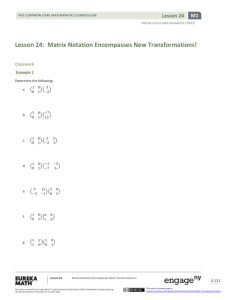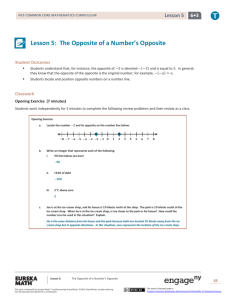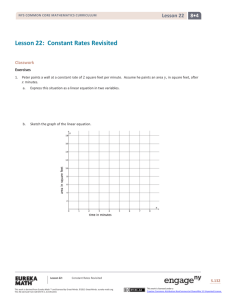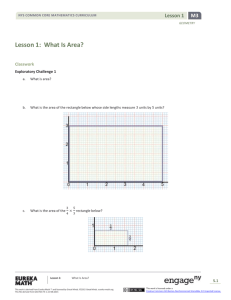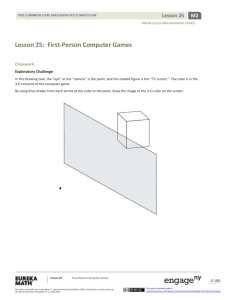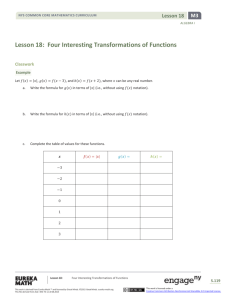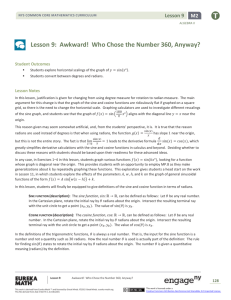Algebra II Module 2, Topic A, Lesson 9: Student Version
advertisement
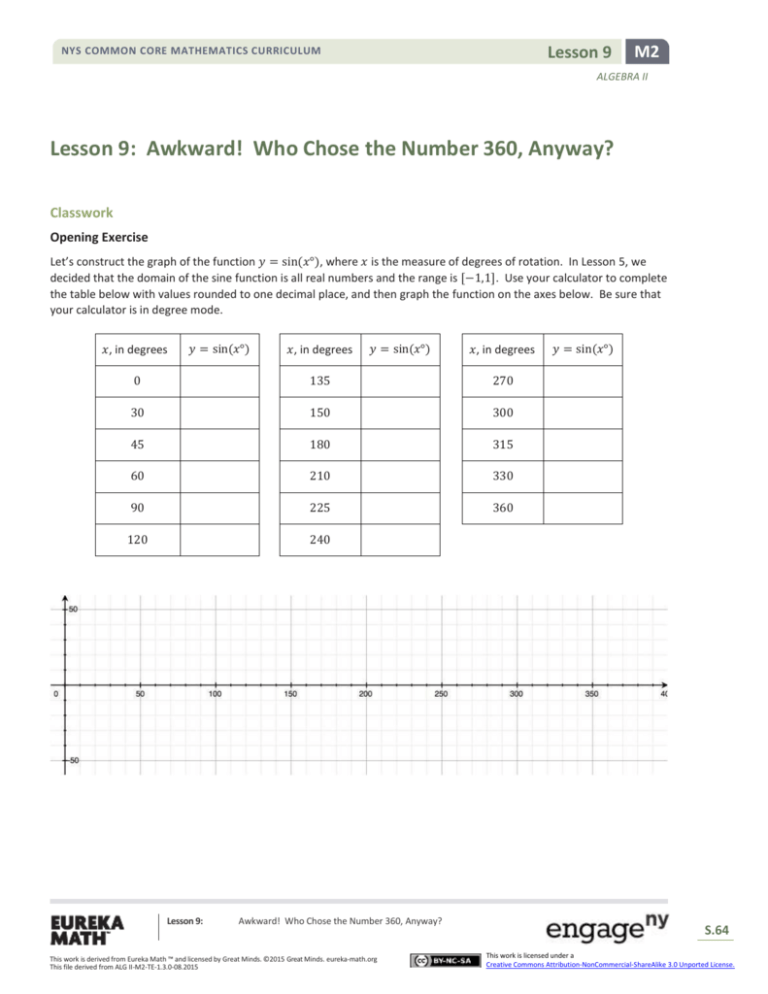
Lesson 9 NYS COMMON CORE MATHEMATICS CURRICULUM M2 ALGEBRA II Lesson 9: Awkward! Who Chose the Number 360, Anyway? Classwork Opening Exercise Let’s construct the graph of the function 𝑦 = sin(𝑥°), where 𝑥 is the measure of degrees of rotation. In Lesson 5, we decided that the domain of the sine function is all real numbers and the range is [−1,1]. Use your calculator to complete the table below with values rounded to one decimal place, and then graph the function on the axes below. Be sure that your calculator is in degree mode. 𝑥, in degrees 𝑦 = sin(𝑥°) 𝑥, in degrees 𝑦 = sin(𝑥°) 𝑥, in degrees 0 135 270 30 150 300 45 180 315 60 210 330 90 225 360 120 240 Lesson 9: Awkward! Who Chose the Number 360, Anyway? This work is derived from Eureka Math ™ and licensed by Great Minds. ©2015 Great Minds. eureka-math.org This file derived from ALG II-M2-TE-1.3.0-08.2015 𝑦 = sin(𝑥°) S.64 This work is licensed under a Creative Commons Attribution-NonCommercial-ShareAlike 3.0 Unported License. NYS COMMON CORE MATHEMATICS CURRICULUM Lesson 9 M2 ALGEBRA II Exercises 1–5 Set your calculator’s viewing window to 0 ≤ 𝑥 ≤ 10 and −2.4 ≤ 𝑦 ≤ 2.4, and be sure that your calculator is in degree mode. Plot the following functions in the same window: 𝑦 = sin(𝑥°) 𝑦 = sin(2𝑥°) 𝑦 = sin(10𝑥°) 𝑦 = sin(50𝑥°) 𝑦 = sin(100𝑥°) 1. This viewing window was chosen because it has close to the same scale in the horizontal and vertical directions. In this viewing window, which of the five transformed sine functions most clearly shows the behavior of the sine function? 2. Describe the relationship between the steepness of the graph 𝑦 = sin(𝑘𝑥°) near the origin and the value of 𝑘. 3. Since we can control the steepness of the graph 𝑦 = sin(𝑘𝑥°) near the origin by changing the value of 𝑘, how steep might we want this graph to be? What is your favorite positive slope for a line through the origin? 4. In the same viewing window on your calculator, plot 𝑦 = 𝑥 and 𝑦 = sin(𝑘𝑥°) for some value of 𝑘. Experiment with your calculator to find a value of 𝑘 so that the steepness of 𝑦 = sin(𝑘𝑥°) matches the slope of the line 𝑦 = 𝑥 near the origin. You may need to change your viewing window to 0 ≤ 𝑥 ≤ 2 and 0 ≤ 𝑦 ≤ 1 to determine the best value of 𝑘. Lesson 9: Awkward! Who Chose the Number 360, Anyway? This work is derived from Eureka Math ™ and licensed by Great Minds. ©2015 Great Minds. eureka-math.org This file derived from ALG II-M2-TE-1.3.0-08.2015 S.65 This work is licensed under a Creative Commons Attribution-NonCommercial-ShareAlike 3.0 Unported License. NYS COMMON CORE MATHEMATICS CURRICULUM Lesson 9 M2 ALGEBRA II 5. A circle is defined by a point and a radius. If we start with a circle of any radius and look at a sector of that circle with an arc length equal to the length of the radius, then the central angle of that sector is always the same size. We define a radian to be the measure of that central angle and denote it by 1 rad. Thus, a radian measures how far one radius will wrap around the circle. For any circle, it takes 2𝜋 ≈ 6.3 radius lengths to wrap around the circumference. In the figure, 6 radius lengths are shown around the circle, with roughly 0.3 radius lengths left over. Use a protractor that measures angles in degrees to find an approximate degree measure for an angle with measure 1 rad. Use one of the figures from the previous discussion. Lesson 9: Awkward! Who Chose the Number 360, Anyway? This work is derived from Eureka Math ™ and licensed by Great Minds. ©2015 Great Minds. eureka-math.org This file derived from ALG II-M2-TE-1.3.0-08.2015 S.66 This work is licensed under a Creative Commons Attribution-NonCommercial-ShareAlike 3.0 Unported License. NYS COMMON CORE MATHEMATICS CURRICULUM Lesson 9 M2 ALGEBRA II Examples 1–4 1. Convert from degrees to radians: 45° 2. Convert from degrees to radians: 33° 3. Convert from radians to degrees: − 4. Convert from radians to degrees: Lesson 9: π rad 3 19π 17 rad Awkward! Who Chose the Number 360, Anyway? This work is derived from Eureka Math ™ and licensed by Great Minds. ©2015 Great Minds. eureka-math.org This file derived from ALG II-M2-TE-1.3.0-08.2015 S.67 This work is licensed under a Creative Commons Attribution-NonCommercial-ShareAlike 3.0 Unported License. Lesson 9 NYS COMMON CORE MATHEMATICS CURRICULUM M2 ALGEBRA II Exercises 6–7 6. Complete the table below, converting from degrees to radians or from radians to degrees as necessary. Leave your answers in exact form, involving 𝜋. Degrees Radians 45° 𝜋 4 120° − 5𝜋 6 3𝜋 2 450° 𝑥° 𝑥 7. On your calculator, graph the functions 𝑦 = 𝑥 and 𝑦 = sin ( the decimal approximation to the constant 180 𝜋 180 𝑥°). What do you notice near the origin? What is 𝜋 to one decimal place? Explain how this relates to what we’ve done in Exercise 4. Lesson 9: Awkward! Who Chose the Number 360, Anyway? This work is derived from Eureka Math ™ and licensed by Great Minds. ©2015 Great Minds. eureka-math.org This file derived from ALG II-M2-TE-1.3.0-08.2015 S.68 This work is licensed under a Creative Commons Attribution-NonCommercial-ShareAlike 3.0 Unported License. NYS COMMON CORE MATHEMATICS CURRICULUM Lesson 9 M2 ALGEBRA II Discussion Lesson 9: Awkward! Who Chose the Number 360, Anyway? This work is derived from Eureka Math ™ and licensed by Great Minds. ©2015 Great Minds. eureka-math.org This file derived from ALG II-M2-TE-1.3.0-08.2015 S.69 This work is licensed under a Creative Commons Attribution-NonCommercial-ShareAlike 3.0 Unported License. Lesson 9 NYS COMMON CORE MATHEMATICS CURRICULUM M2 ALGEBRA II Lesson Summary A radian is the measure of the central angle of a sector of a circle with arc length of one radius length. There are 2𝜋 radians in a 360° rotation, also known as a turn, so degrees are converted to radians and radians to degrees by: 2𝜋 rad = 1 turn = 360 °. SINE FUNCTION (description): The sine function, sin: ℝ → ℝ, can be defined as follows: Let 𝜃 be any real number. In the Cartesian plane, rotate the initial ray by 𝜃 radians about the origin. Intersect the resulting terminal ray with the unit circle to get a point (𝑥𝜃 , 𝑦𝜃 ). The value of sin(𝜃) is 𝑦𝜃 . COSINE FUNCTION (description): The cosine function, cos: ℝ → ℝ, can be defined as follows: Let 𝜃 be any real number. In the Cartesian plane, rotate the initial ray by 𝜃 radians about the origin. Intersect the resulting terminal ray with the unit circle to get a point (𝑥𝜃 , 𝑦𝜃 ). The value of cos(𝜃) is 𝑥𝜃 . Problem Set 1. Use a radian protractor to measure the amount of rotation in radians of ray 𝐵𝐴 to ray 𝐵𝐶 in the indicated direction. Measure to the nearest 0.1 radian. Use negative measures to indicate clockwise rotation. a. b. c. d. e. f. Lesson 9: Awkward! Who Chose the Number 360, Anyway? This work is derived from Eureka Math ™ and licensed by Great Minds. ©2015 Great Minds. eureka-math.org This file derived from ALG II-M2-TE-1.3.0-08.2015 S.70 This work is licensed under a Creative Commons Attribution-NonCommercial-ShareAlike 3.0 Unported License. Lesson 9 NYS COMMON CORE MATHEMATICS CURRICULUM M2 ALGEBRA II g. 2. h. Complete the table below, converting from degrees to radians. Where appropriate, give your answers in the form of a fraction of 𝜋. Degrees Radians 90° 300° −45° −315° −690° 3 3 ° 4 90𝜋° − Lesson 9: 45° 𝜋 Awkward! Who Chose the Number 360, Anyway? This work is derived from Eureka Math ™ and licensed by Great Minds. ©2015 Great Minds. eureka-math.org This file derived from ALG II-M2-TE-1.3.0-08.2015 S.71 This work is licensed under a Creative Commons Attribution-NonCommercial-ShareAlike 3.0 Unported License. Lesson 9 NYS COMMON CORE MATHEMATICS CURRICULUM M2 ALGEBRA II 3. Complete the table below, converting from radians to degrees. Radians Degrees 𝜋 4 𝜋 6 5𝜋 12 11𝜋 36 7𝜋 − 24 11𝜋 − 12 49𝜋 49𝜋 3 4. Use the unit circle diagram from the end of the lesson and your knowledge of the six trigonometric functions to complete the table below. Give your answers in exact form, as either rational numbers or radical expressions. 𝜃 cos(𝜃) sin(𝜃) tan(𝜃) cot(𝜃) sec(𝜃) csc(𝜃) 𝜋 3 3𝜋 4 5𝜋 6 0 − 3𝜋 4 − 7𝜋 6 − 11𝜋 3 Lesson 9: Awkward! Who Chose the Number 360, Anyway? This work is derived from Eureka Math ™ and licensed by Great Minds. ©2015 Great Minds. eureka-math.org This file derived from ALG II-M2-TE-1.3.0-08.2015 S.72 This work is licensed under a Creative Commons Attribution-NonCommercial-ShareAlike 3.0 Unported License. Lesson 9 NYS COMMON CORE MATHEMATICS CURRICULUM M2 ALGEBRA II 5. Use the unit circle diagram from the end of the lesson and your knowledge of the sine, cosine, and tangent functions to complete the table below. Select values of 𝜃 so that 0 ≤ 𝜃 < 2𝜋. 𝜃 cos(𝜃) sin(𝜃) 1 2 −√3 − − √2 2 √2 2 1 √2 2 −1 0 tan(𝜃) 0 −1 − 1 2 √3 3 6. How many radians does the minute hand of a clock rotate through over 10 minutes? How many degrees? 7. How many radians does the minute hand of a clock rotate through over half an hour? How many degrees? 8. What is the radian measure of an angle subtended by an arc of a circle with radius 4 cm if the intercepted arc has length 14 cm? How many degrees? 9. What is the radian measure of an angle formed by the minute and hour hands of a clock when the clock reads 1:30? How many degrees? (Hint: You must take into account that the hour hand is not directly on the 1.) 10. What is the radian measure of an angle formed by the minute and hour hands of a clock when the clock reads 5:45? How many degrees? 11. How many degrees does the earth revolve on its axis each hour? How many radians? 12. The distance from the equator to the North Pole is almost exactly 10,000 km. a. Roughly how many kilometers is 1 degree of latitude? b. Roughly how many kilometers is 1 radian of latitude? Lesson 9: Awkward! Who Chose the Number 360, Anyway? This work is derived from Eureka Math ™ and licensed by Great Minds. ©2015 Great Minds. eureka-math.org This file derived from ALG II-M2-TE-1.3.0-08.2015 S.73 This work is licensed under a Creative Commons Attribution-NonCommercial-ShareAlike 3.0 Unported License.


